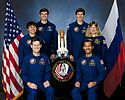STS-60
 | |
| Dane misji | |
| Indeks COSPAR | 1994-006A |
|---|---|
| Zaangażowani | |
| Oznaczenie kodowe | STS-60 |
| Pojazd | |
| Wahadłowiec | |
| Załoga | |
 | |
| Dowódca | |
| Start | |
| Miejsce startu | |
| Początek misji | |
| Orbita okołoziemska | |
| Apogeum | 354 km |
| Lądowanie | |
| Miejsce lądowania | KSC, Pas startowy 15 |
| Lądowanie | 11 lutego 1994 19:19:22 UTC[1] |
| Czas trwania misji | 8 dni, 7 godz., 9 min, 22 sek[1] |
| Przebyta odległość | 5 535 666 km[2] |
| Liczba okrążeń Ziemi | 130[1] |
| Program lotów wahadłowców | |
STS-60 (ang. Space Transportation System) – pierwsza misja wahadłowca Discovery w ramach amerykańsko-rosyjskiego programu Shuttle-Mir. Po raz pierwszy w historii na pokładzie amerykańskiego wahadłowca znajdował się rosyjski kosmonauta. Był to osiemnasty lot promu kosmicznego Discovery i sześćdziesiąty programu lotów wahadłowców[3].
Załoga
- źródło[3]
- Charles Bolden (4)*, dowódca
- Kenneth Reightler (2), pilot
- Nancy Jan Davis (2), specjalista misji 1
- Ronald Sega (1), specjalista misji 2
- Franklin Chang-Díaz (4), specjalista misji 3
- Siergiej Krikalow (3), specjalista misji 4 (Rosja)
- *(liczba w nawiasie oznacza liczbę lotów odbytych przez każdego z astronautów)
Cel misji
Lot naukowy laboratorium Spacehab-02; umieszczenie na orbicie, a następnie przechwycenie satelity WSF-1 (Wake Shield Facility) – to zadanie się nie powiodło i WSF-1 prowadził eksperymenty umocowany do końcówki wysięgnika RMS[3].
Parametry misji
- źródło[2]
- Masa:
- startowa orbitera: 111 256 kg
- lądującego orbitera: 97 495 kg
- ładunku: 13 006 kg
- Perygeum: 348 km
- Apogeum: 351 km
- Inklinacja: 56,4°
- Okres orbitalny: 91,5 min
Zobacz też
Przypisy
Linki zewnętrzne
- podsumowanie misji STS-60 na stronie KSC (ang.)
- Mark Wade: STS-60 (ang.). W: Encyclopedia Astronautica [on-line]. [dostęp 2017-07-25].
- Spaceflight mission report: STS-60 (ang.). Spacefacts. [dostęp 2017-07-25].
Media użyte na tej stronie
The flag of Navassa Island is simply the United States flag. It does not have a "local" flag or "unofficial" flag; it is an uninhabited island. The version with a profile view was based on Flags of the World and as a fictional design has no status warranting a place on any Wiki. It was made up by a random person with no connection to the island, it has never flown on the island, and it has never received any sort of recognition or validation by any authority. The person quoted on that page has no authority to bestow a flag, "unofficial" or otherwise, on the island.
STS-60 crew patch
- The design of the crew patch for NASA's STS-60 mission depicts the Space Shuttle Discovery's on-orbit configuration. The American and Russian flags symbolize the partnership of the two countries and their crew members taking flight into space together for the first time. The open payload bay contains: the Space Habitation Module (Spacehab), a commercial space laboratory for life and material science experiments; and a Getaway Special Bridge Assembly in the aft section carrying various experiments, both deployable and attached. A scientific experiment to create and measure an ultra-vacuum environment and perform semiconductor material science – the Wake Shield Facility – is shown on the Remote Manipulator System (RMS) prior to deployment.
Five NASA astronauts and a Russian Cosmonaut take a break from training for their scheduled flight in space to pose for the traditional crew portrait. In the front (left to right) are Astronauts Kenneth S. Reightler Jr., and Charles F. Bolden Jr., pilot and commander, respectively. On middle row are Astronauts Franklin R. Chang-Diaz and N. Jan Davis, mission specialists. On back row are Astronaut Ronald M. Sega (left) and Russia's Sergei K. Krikalev, both mission specialists.
The NASA gallery provided the following description of the image: "The Wake Shield Facility (WSF) is a free-flying research and development facility that is designed to use the pure vacuum of space to conduct scientific research in the development of new materials. The thin film materials technology developed by the WSF could some day lead to applications such as faster electronics components for computers.
The official NASA patch for the Shuttle-Mir Program, showing a Space Shuttle Orbiter docked to the Russian Space Station Mir, flying above a stylised Earth. The patch is bordered by the colours of the flags of Russia and the USA






